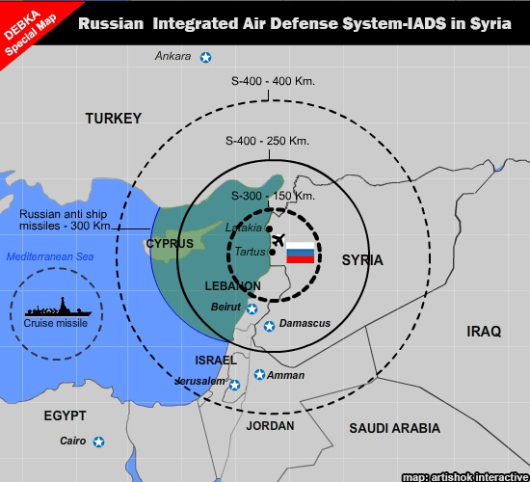Russia’s New Multilevel Missile Shield Makes Syria a No-Fly Zone
It was admitted in the ongoing dialogue this week between Washington and London that Western support for any military action against Bashar Assad’s chief backer, Russia, was too weak to have any real effect on the situation in Syria.
This was reflected strongly in the decisions reached by European Union foreign ministers, when they met in Luxembourg Monday, Oct. 17 to discuss the plight of the people of Aleppo and Russia’s role in it.
“This has not been proposed by any member state,” said EU foreign policy chief Federica Mogherini in reference to the notion of expanding sanctions against Russia over its intervention in Syria.
“But we will have sanctions on the Syrian regime,” she added.
Russian President Vladimir Putin swiftly seized on this immunity from Western military and diplomatic counter-measures as the go-ahead for his plans for Syria.
That same Monday, the Russian Navy announced the deployment of the aircraft carrier Admiral Kuznetsov for its first combat mission in the Mediterranean Sea. Until now, Russia’s Mediterranean fleet consisted of six warships and three or four support vessels at any one time.
Moscow is clearly covering its flanks as the construction of the Russian military enclave in Syria goes forward (as first revealed in DEBKA Weekly 727 on Oct. 7: How Far Will Obama and Putin Go in Their Duel over Syria?)
This project faces no real threat. The Obama administration has no intention of lifting a military finger against Russia, whereas Putin is in full military momentum, adding the last piece to the master plan whose implementation he kicked off with Russia’s military intervention in Syria in September 2015.
This plan is designed to elevate Russia as lead power in the Middle East by superseding and displacing American influence.
That last piece, according to DEBKA Weekly’s military sources, is the deployment in Syria of an expeditionary integrated air defense system, an air defense missile shield known as IADS.
The presence of a Russian IADS in Syria must raise the risks facing continued US coalition military intervention in the Syrian war to an unacceptable level.
It is being built up step by step:
1. On Oct. 3, a Russian S-300 air defense missile system (NATO-named SA-23) was installed at the Russian-leased section of the Syrian naval base of Tartus. It joined the S-400 long-range air defense system (NATO-named SA-21 Growler) and the S-200 (SA-5 Gammon) already present in Syria.
2. The short-range Russian air defense systems present in Syria included the Pantsir-S1 and Buk missile systems, and the naval version of the S-300 aboard a Slava-class guided missile cruiser, on the Mediterranean.
3. All these present and fully operational air defense systems, culminating in the highly mobile IADS, have radically changed the regional strategic balance of strength. It could pose a direct threat to US and coalition aircraft and a deterrent to any further coalition involvement, and certainly, any escalation of aerial operations.
In contrast, Russian forces in Syria face no credible threat that would call for an IADS presence – whether from the Islamic State or any fixed wing, rotary wing or ballistic missile in the neighborhood The Russian missile shield’s sole function in Syria is to make that country’s skies inhospitable to the US and its coalition and so make them cede this patch of airspace to exclusive Russian domination.


